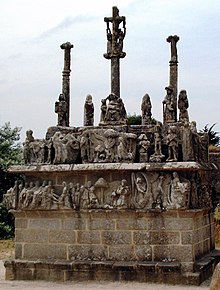Bretons
[11] There is reason to believe that this number includes the department of Loire-Atlantique, which the Vichy government separated from historical Brittany in 1941.
In 2018, a study commissioned by the administrative region of Brittany (Loire-Atlantique included) revealed that 5.5% of Bretons considered that they spoke the language (around 213,000 people).
In the late fourth century, large numbers of British auxiliary troops in the Roman army may have been stationed in Armorica.
The ninth-century Historia Brittonum states that the emperor Magnus Maximus, who withdrew Roman forces from Britain, settled his troops in the province.
Nennius and Gildas mention a second wave of Britons settling in Armorica in the following century to escape the invading Anglo-Saxons and Scoti.
There are numerous records of Celtic Christian missionaries migrating from Britain during the second wave of Breton colonisation, especially the legendary seven founder-saints of Brittany as well as Gildas.
The first two kingdoms seem to derive their names from the homelands of the migrating tribes in Britain, Cornwall (Kernow) and Devon (Dumnonia).
The rulers of Domnonée, such as Conomor, sought to expand their territory, claiming overlordship over all Bretons, though there was constant tension between local lords.
Many people throughout France claim Breton ethnicity, including a few French celebrities such as Marion Cotillard,[17] Suliane Brahim,[18] Malik Zidi,[19] Patrick Poivre d'Arvor, Yoann Gourcuff, Nolwenn Leroy and Yann Tiersen.
According to data from the administrative region of Brittany, around 400 000 Bretons live in a country other than France[22], most notably in Canada and the United States.
In Paris, Bretons used to settle in the neighborhood around the Montparnasse train station, which is also the terminus of the Paris-Brest railway.
This includes the Tro Breizh, which takes place in the shrines of the seven founding saints of Breton Christianity.
In 2002, the Tro Breizh included a special pilgrimage to Wales, symbolically making the reverse journey of the Welshmen Paul Aurelian, Brioc, and Samson.
[citation needed] There are four main Breton dialects: Gwenedeg (Vannes), Kerneveg (Cornouaille), Leoneg (Leon) and Tregerieg (Trégor), which have varying degrees of mutual intelligibility.
Gallo shares certain areal features such as points of vocabulary, idiom, and pronunciation with Breton, but is a Romance language.
This law allowed Breton language and culture to be taught 1–3 hours a week in the public school system on the provision that a teacher was both able and prepared to do so.
Fest-Noz was officially registered on Wednesday, December 5, 2012, by UNESCO on the "Representative List of the Intangible Cultural Heritage of Humanity."
Traditional instruments include the bombard (similar to an oboe) and two types of bagpipes (veuze and binioù kozh).
After World War II, the Great Highland bagpipe (and binioù bras) became commonplace in Brittany through the bagadoù (Breton pipe bands) and thus often replaced the binioù-kozh.
Nowadays groups with many different styles of music may be found, ranging from rock to jazz such as Red Cardell, ethno-rock, Diwall and Skeduz as well as punk.
Some modern fest-noz groups also use electronic keyboards and synthesisers, for example Strobinell, Sonerien Du, Les Baragouineurs, and Plantec.







